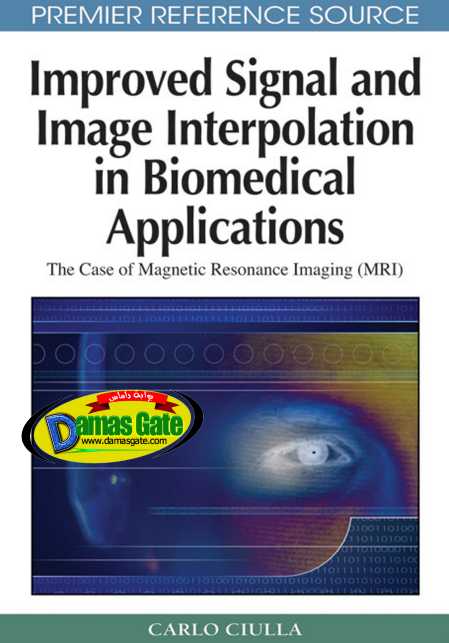Improved Signal and Image Interpolation in Biomedical Applications:
The Case of Magnetic Resonance Imaging (MRI)
Carlo Ciulla
Lane College, USA

Preface
OVERVIEW OF THE SUBJECT MATTER
“If I am anything, which I highly doubt, I have made myself so by hard work.” Isaac Newton
This book presents a novel theoretical framework for the improvement of the interpolation error from which is derived a
unified
methodology applied to several interpolation paradigms: two and three-dimensional linear,
one-dimensional quadratic and cubic B-Splines, Lagrange, and Sinc. Advances are
made to derive a framework that is unifying in its purpose and that thus achieves improvement
of the approximation properties of the interpolation function regardless to its dimensionality or
degree. The framework proposes a mathematical formulation, which consequentially to its
developmental approach formulates interpolation error improvement
as dependent from the joint information content of node intensity and the
second order derivative of the interpolation function. From the theory
herein developed, the mathematical formulation is derived by two
main intuitions called the Intensity-Curvature Functional and the
Sub-pixel Efficacy Region, and these are such to set the grounds for the
improvement of the interpolation error. From the theory it descends that given
a location where the interpolation function ought to estimate the value
of the unknown signal, a novel sub-pixel (intra-node) re-sampling location
is determined which varies locally pixel-by-pixel (node-by-node). The novel
theory asserts and demonstrates by a-posteriori knowledge, that the interpolation
error improvement can be achieved based on the joint information content of the
node intensity and the second order derivative of the interpolation function.
Consequentially to the formulation, re-sampling is performed locally at locations that are
variable depending on the signal intensity at the neighborhood and local curvature of the interpolator
.
The book initiates presenting two mathematical intuitions and given that absolute
truth cannot be reached by them, the intuitions serve the purpose to derive novel conceptions of
interpolation error improvement. These conceptions are determined during a process driven
through deduction and thus a theoretical framework is presented. The boundary
of the truth determined through the mathematical intuitions in explaining interpolation
error improvement are empirically tested. The
purpose of the theory is that of unifying under the same approach interpolators of
diverse degree and dimensionality such to determine novel interpolation functions so
called: SRE-based interpolation functions, which possess improved approximation characteristics. The bridging concept between SRE-based and classic interpolation functions is the local curvature of the function as expressed by the second order derivative. There are extended mathematical descriptions of the theory with detailed formulations to conceptualize the steps of the approach. Also, improved interpolation functions are validated experimentally by a motion correction paradigm.
Download
*
The Case of Magnetic Resonance Imaging (MRI)
Carlo Ciulla
Lane College, USA

Preface
OVERVIEW OF THE SUBJECT MATTER
“If I am anything, which I highly doubt, I have made myself so by hard work.” Isaac Newton
This book presents a novel theoretical framework for the improvement of the interpolation error from which is derived a
unified
methodology applied to several interpolation paradigms: two and three-dimensional linear,
one-dimensional quadratic and cubic B-Splines, Lagrange, and Sinc. Advances are
made to derive a framework that is unifying in its purpose and that thus achieves improvement
of the approximation properties of the interpolation function regardless to its dimensionality or
degree. The framework proposes a mathematical formulation, which consequentially to its
developmental approach formulates interpolation error improvement
as dependent from the joint information content of node intensity and the
second order derivative of the interpolation function. From the theory
herein developed, the mathematical formulation is derived by two
main intuitions called the Intensity-Curvature Functional and the
Sub-pixel Efficacy Region, and these are such to set the grounds for the
improvement of the interpolation error. From the theory it descends that given
a location where the interpolation function ought to estimate the value
of the unknown signal, a novel sub-pixel (intra-node) re-sampling location
is determined which varies locally pixel-by-pixel (node-by-node). The novel
theory asserts and demonstrates by a-posteriori knowledge, that the interpolation
error improvement can be achieved based on the joint information content of the
node intensity and the second order derivative of the interpolation function.
Consequentially to the formulation, re-sampling is performed locally at locations that are
variable depending on the signal intensity at the neighborhood and local curvature of the interpolator
.
The book initiates presenting two mathematical intuitions and given that absolute
truth cannot be reached by them, the intuitions serve the purpose to derive novel conceptions of
interpolation error improvement. These conceptions are determined during a process driven
through deduction and thus a theoretical framework is presented. The boundary
of the truth determined through the mathematical intuitions in explaining interpolation
error improvement are empirically tested. The
purpose of the theory is that of unifying under the same approach interpolators of
diverse degree and dimensionality such to determine novel interpolation functions so
called: SRE-based interpolation functions, which possess improved approximation characteristics. The bridging concept between SRE-based and classic interpolation functions is the local curvature of the function as expressed by the second order derivative. There are extended mathematical descriptions of the theory with detailed formulations to conceptualize the steps of the approach. Also, improved interpolation functions are validated experimentally by a motion correction paradigm.
Download
*